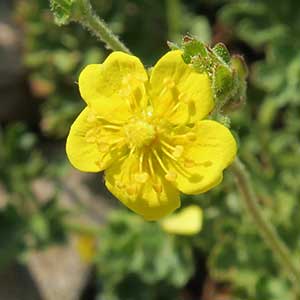|
Newberry's cinquefoil
|
short-leaf cinquefoil, sparse-leaf cinquefoil
|
petiole 1–3.5 cm, long hairs ± abundant, 0.5–1.5 mm, short hairs absent or sparse, rarely common; leaflets 0.2–1 cm, lobes oblanceolate to narrowly elliptic, (0.5–)1–2 mm wide, longs hairs ± abundant, short hairs absent or sparse, glands sparse to abundant. |
petiole 1–4 cm, eglandular hairs absent or sparse, spreading, less than 1 mm, weak, glands abundant. |
epicalyx bractlets broadly lanceolate to elliptic, 1.5–4(–5) × (0.4–)0.8–1.3 mm; sepals 2–4(–5) mm, apex ± acute; petals (3–)4–6 × (2–)3–5 mm; filaments 1–2(–2.5) mm, anthers 0.4–0.6 mm; carpels 20–50. |
epicalyx bractlets lanceolate-elliptic to ovate, 2–4 × 0.8–2 mm; sepals 3–5(–7) mm, apex broadly acute to obtuse; petals 3.5–6.5 × 3–5 mm; filaments 1–2.5 mm, anthers 0.5–0.6 mm; carpels 10–15. |
0.9–1.2 mm. |
1–1.5 mm. |
|
|
|
|
| Flowering summer. |
Flowering summer. |
| Moist, sandy to clayey, more or less alkaline soil, especially where seasonally inundated near streams, ponds, and lakes |
Moist rocky slopes and talus, alpine grassy areas, subalpine conifer woodlands |
| 1300–1800 m (4300–5900 ft) |
2500–3600 m (8200–11800 ft) |
|
CA; NV; OR; WA
|
ID; MT; NV; OR; WY
|
Potentilla newberryi grows in valley bottoms in south-central Oregon, northeastern California, and northwestern Nevada. The only specimen supposedly collected in south-central Washington (W. N. Suksdorf 2718, WTU) was gathered in 1898. (Discussion copyrighted by Flora of North America; reprinted with permission.) |
Potentilla brevifolia is found mainly in alpine situations in the Pioneer, Sawtooth, Smoky, and White Cloud mountains of central Idaho; the Madison Range of western Montana; the Jarbidge Range of northeastern Nevada; the Blue, Steens, and Wallowa mountains of eastern Oregon; and the Teton Range of northwestern Wyoming. The elongate caudices are easily covered by moving soil and talus. (Discussion copyrighted by Flora of North America; reprinted with permission.) |
| FNA vol. 9, p. 137. |
FNA vol. 9, p. 188. |
| Rosaceae > subfam. Rosoideae > tribe Potentilleae > Potentilla > sect. Arenicolae |
Rosaceae > subfam. Rosoideae > tribe Potentilleae > Potentilla > sect. Brevifoliae |
P. albiflora, P. ambigens, P. anachoretica, P. angelliae, P. anglica, P. anserina, P. arenosa, P. argentea, P. arizonica, P. basaltica, P. bicrenata, P. biennis, P. biflora, P. bimundorum, P. bipinnatifida, P. brevifolia, P. breweri, P. bruceae, P. brunnescens, P. canadensis, P. concinna, P. cottamii, P. crantzii, P. crebridens, P. crinita, P. cristae, P. demotica, P. drummondii, P. effusa, P. elegans, P. erecta, P. flabellifolia, P. fragiformis, P. furcata, P. glaucophylla, P. gracilis, P. grayi, P. hickmanii, P. hippiana, P. holmgrenii, P. hookeriana, P. hyparctica, P. inclinata, P. intermedia, P. jepsonii, P. johnstonii, P. lasiodonta, P. litoralis, P. macounii, P. millefolia, P. modesta, P. morefieldii, P. multijuga, P. multisecta, P. nana, P. nivea, P. norvegica, P. ovina, P. paucijuga, P. pedersenii, P. pensylvanica, P. plattensis, P. pseudosericea, P. pulchella, P. pulcherrima, P. recta, P. reptans, P. rhyolitica, P. rimicola, P. rivalis, P. robbinsiana, P. rubella, P. rubricaulis, P. sanguinea, P. saximontana, P. sierrae-blancae, P. simplex, P. sterilis, P. stipularis, P. subgorodkovii, P. subjuga, P. subvahliana, P. subviscosa, P. supina, P. thurberi, P. thuringiaca, P. tikhomirovii, P. townsendii, P. uliginosa, P. uschakovii, P. vahliana, P. verna, P. versicolor, P. villosa, P. villosula, P. vulcanicola, P. wheeleri |
P. albiflora, P. ambigens, P. anachoretica, P. angelliae, P. anglica, P. anserina, P. arenosa, P. argentea, P. arizonica, P. basaltica, P. bicrenata, P. biennis, P. biflora, P. bimundorum, P. bipinnatifida, P. breweri, P. bruceae, P. brunnescens, P. canadensis, P. concinna, P. cottamii, P. crantzii, P. crebridens, P. crinita, P. cristae, P. demotica, P. drummondii, P. effusa, P. elegans, P. erecta, P. flabellifolia, P. fragiformis, P. furcata, P. glaucophylla, P. gracilis, P. grayi, P. hickmanii, P. hippiana, P. holmgrenii, P. hookeriana, P. hyparctica, P. inclinata, P. intermedia, P. jepsonii, P. johnstonii, P. lasiodonta, P. litoralis, P. macounii, P. millefolia, P. modesta, P. morefieldii, P. multijuga, P. multisecta, P. nana, P. newberryi, P. nivea, P. norvegica, P. ovina, P. paucijuga, P. pedersenii, P. pensylvanica, P. plattensis, P. pseudosericea, P. pulchella, P. pulcherrima, P. recta, P. reptans, P. rhyolitica, P. rimicola, P. rivalis, P. robbinsiana, P. rubella, P. rubricaulis, P. sanguinea, P. saximontana, P. sierrae-blancae, P. simplex, P. sterilis, P. stipularis, P. subgorodkovii, P. subjuga, P. subvahliana, P. subviscosa, P. supina, P. thurberi, P. thuringiaca, P. tikhomirovii, P. townsendii, P. uliginosa, P. uschakovii, P. vahliana, P. verna, P. versicolor, P. villosa, P. villosula, P. vulcanicola, P. wheeleri |
| Ivesia gracilis |
|
| A. Gray: Proc. Amer. Acad. Arts 6: 532. (1865) — not P. gracilis Douglas ex Hooker 1830 |
Nuttall: in J. Torrey and A. Gray, Fl. N. Amer. 1: 442. (1840) |
| |
CA,
OR,
WA
CalFlora,
CalPhotos,
Flora NW,
PNW Herbaria
WildflowerSearch
iNaturalist (observations)
USDA Plants Database


